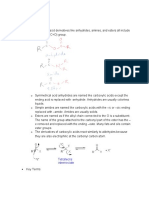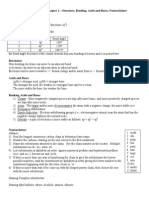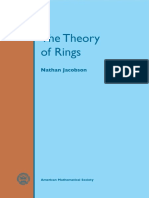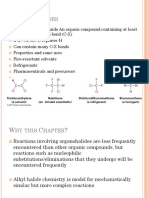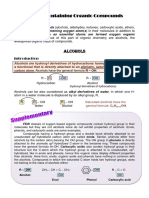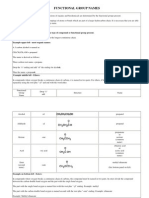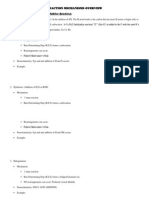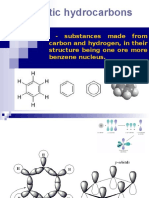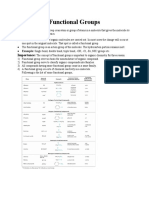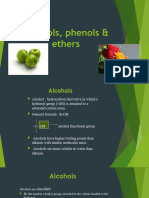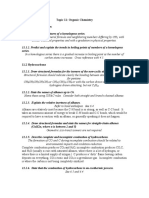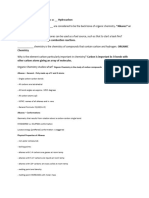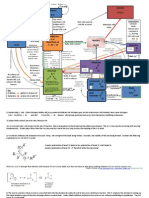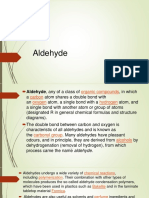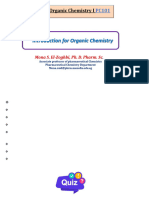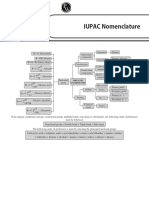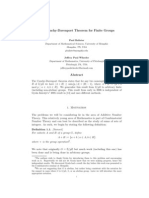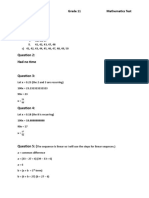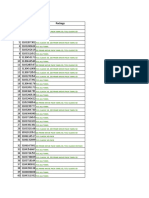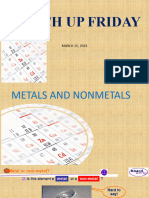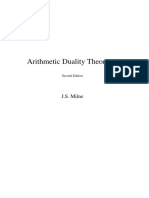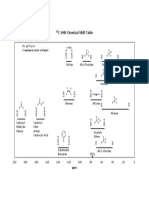0 ratings0% found this document useful (0 votes)
84 viewsFunctional Groups in Organic Chemistry
Functional Groups in Organic Chemistry
Uploaded by
gznmemberList of functional groups commonly found in pre-university or college level organic chemistry syllabus. Cheatsheet for organic chemistry exams.
Copyright:
© All Rights Reserved
Available Formats
Download as PDF, TXT or read online from Scribd
Functional Groups in Organic Chemistry
Functional Groups in Organic Chemistry
Uploaded by
gznmember0 ratings0% found this document useful (0 votes)
84 views1 pageList of functional groups commonly found in pre-university or college level organic chemistry syllabus. Cheatsheet for organic chemistry exams.
Copyright
© © All Rights Reserved
Available Formats
PDF, TXT or read online from Scribd
Share this document
Did you find this document useful?
Is this content inappropriate?
List of functional groups commonly found in pre-university or college level organic chemistry syllabus. Cheatsheet for organic chemistry exams.
Copyright:
© All Rights Reserved
Available Formats
Download as PDF, TXT or read online from Scribd
Download as pdf or txt
0 ratings0% found this document useful (0 votes)
84 views1 pageFunctional Groups in Organic Chemistry
Functional Groups in Organic Chemistry
Uploaded by
gznmemberList of functional groups commonly found in pre-university or college level organic chemistry syllabus. Cheatsheet for organic chemistry exams.
Copyright:
© All Rights Reserved
Available Formats
Download as PDF, TXT or read online from Scribd
Download as pdf or txt
You are on page 1of 1
Summary Sheet - Functional Groups (1)
"Master Organic Chemistry"
masterorganicchemistry.com
August 2012 Version 1.1
Note - this sheet is not meant to be comprehensive. Your course
may provide additional material, or may not cover some of the
reactions shown here. Your course instructor is the final authority.
Omissions, Mistakes, Suggestions?
james@masterorganicchemistry.com
This sheet copyright 2012, James A. Ashenhurst
http://masterorganicchemistry.com
What Are Functional Groups?
Functional groups are collections of atoms that have a common pattern of chemical
reactivity
Alkane
R
C
O
H
C C
H
H H
H3C
H
3
C
H2
C
CH
3
a hydrocarbon with no multiple bonds is an alkane
Characteristics: nonpolar
Geometry: tetrahedral (sp
3
hybridized)
Reactivity: free radical reactions (e.g. free radical chlorination or bromination)
Alkene
a hydrocarbon with at least one CC double
bond (! bond) is an alkene
Characteristics: nonpolar. Molecule cannot rotate along double bond.
Geometry: trigonal planar (sp
2
hybridized)
Reactivity: undergo addition reactions, as well as oxidative cleavage
Stability increases with increasing # of carbons attached
C C H H
3
C
Alkyne
a hydrocarbon with at least one CC
triple bond (! bond) is an alkyne
Alkynes with a CH bond are called "terminal" alkynes
Characteristics: non polar
Reactivity: addition reactions
oxidative cleavage reactions
acid-base reactions (terminal alkynes are unusually acidic)
Propyne
a terminal alkyne
2-butyne 3-heptyne
Propane Butane
( )
8
Decane 2-methylpentane
Propene trans-2-butene
[or (E)-2-butene]
cis-2-butene
[or (Z)-2-butene]
(E)-3,5-dimethylhex-2-ene
Benzene ring
A six-membered ring containing
3 alternating double bonds is a
benzene ring
Benzene Methylbenzene
(toluene)
1,4-dimethylbenzene
(para-dimethylbenzene)
Geometry: linear (sp hybridized)
Examples:
Examples:
Examples:
Examples:
Alcohol
OH
H
3
C
OH
The OH group is an alcohol [unless OH is attached to C=O,
in which case it's a carboxylic acid (below)]
Characteristics: polar (O-H group participates in hydrogen bonding)
Methanol Ethanol
a primary alcohol
2-propanol ("Isopropanol")
a secondary alcohol
Examples: OH
OH
2-methyl-2-propanol
(t-butanol)
a tertiary alcohol
R O H
" "
+
Reactivity: acid-base reactions (can act as acids or bases)
substitution reactions (can act as nucleophiles)
oxidation reactions (primary and secondary alcohols (and methanol)
can be oxidized to aldehydes, ketones, or carboxylic acids, depending
on structure and reagent used)
Ether
O
H
3
C
O
An oxygen flanked by two carbons is an ether
Characteristics: borderline between nonpolar and polar (due to dipole-dipole)
Dimethyl ether
Examples:
R O R
" "
+
Reactivity: acid-base reactions (oxygen can act as a very weak base
CH
3
Ethyl methyl ether
(or "methoxyethane")
Methyl phenyl ether
(or "methoxybenzene",
or "anisole")
O
Alkyl halide F R Cl R Br R I R
"
+
"
+
"
+
"
+ "
"
"
"
An alkyl group attached to
a halogen is an alkyl halide
Characteristics: generally considered non polar (but more polar than alkanes)
Reactivity: substitution reactions (Cl, Br, I can be good leaving groups)
elimination reactions (Cl, Br, I can be good leaving groups)
F
H
3
C
I
Iodomethane
(methyl iodide)
Fluoroethane
(ethyl fluoride)
a primary alkyl
halide
2-chloropropane
(isopropyl chloride)
a secondary alkyl halide
Examples:
Cl
Br
2-methyl-2-bromopropane
(t-butyl bromide)
a tertiary alkyl halide
Reactivity: substitution reactions (e.g. electrophilic aromatic substitution
or nucleophilic aromatic substitution)
C C
C
C C
O
Tetrahydrofuran (THF)
a cyclic ether
Suffix: "-ane". As a substituent: "alkyl"
Suffix: "-ene". As a substituent: "alkenyl"
Suffix: "-yne". As a substituent: "alkynyl"
Suffix: "benzene". As a substituent: "phenyl"
Suffix: "-ol". As a substituent: "hydroxy"
As a substituent: "alkoxy"
Suffix: "-ane". As a substituent: "haloalkyl"
Amine
NH2 H
3
C
NH
2
A nitrogen attached to simple carbon or
hydrogen atoms is an amine
Methylamine Ethylamine
a primary amine
Dimethylamine
a secondary amine
Examples:
H
N
Triethylamine
a tertiary amine
R N H
" "
+
H
Suffix: "-ine". As a substituent: "amino"
N
Characteristics: polar (N-H group participates in hydrogen bonding, although not as
much as a hydroxy group
Reactivity: acid-base reactions (tend to act as bases)
substitution reactions (can act as nucleophiles)
Aldehyde
A carbonyl (C=O) attached to a hydrogen
and another carbon is an aldehyde
Ethanal Propanal Butanal
Examples:
Benzaldehyde
"
#
"
+
Suffix: "-al" (if attached to ring: carbaldehyde) As a substituent: "oxo"
Characteristics: the C=O bond is somewhat polar
Reactivity: addition reactions (the carbonyl carbon reacts easily with nucleophiles)
H
3
C
C
O
H
O
H
O
H
O
H
R
C
O
R
Ketone
A carbonyl (C=O) flanked by two carbons
is a ketone
Examples:
"
#
"
+
Suffix: "-one". As a substituent: "oxo"
2-propanone
("acetone")
H
3
C
C
O
CH
3
2-butanone
("methyl ethyl ketone")
O
Characteristics: the C=O bond is somewhat polar (less so than O-H however)
Reactivity: addition reactions (the carbonyl carbon reacts easily with nucleophiles)
O
phenyl methyl ketone
("acetophenone")
3-hexanone
O
acid-base reactions (carbons adjacent to the ketone can be deprotonated
to give enolates)
R
C
O
O
Carboxylic acid
A carbonyl (C=O) adjacent to a hydroxyl
(OH) and an R group is a carboxylic acid
"
#
"
+
Suffix: "-oic acid"
H
"
#
"
+
Examples:
Methanoic acid
("formic acid")
H
C
O
OH
Ethanoic acid
("acetic acid")
O
OH
O
OH
benzoic acid Butanoic acid
O
R
C
O
O
Ester
A carbonyl (C=O) adjacent to an alkoxy
(OR) and an R group is an ester
"
#
"
+
Suffix: "-oate"
Examples:
Methyl methanoate
H
C
O
OCH3
Methyl ethanoate
O
O
O
O
Methyl benzoate Ethyl butanoate
O
O
R
Reactivity: acid-base reactions (the OH is acidic)
acyl substitution reactions (can replace OH with other groups under
acidic conditions)
Reactivity: acyl substitution reactions (can replace OR with other functional
groups under acidic conditions)
addition reactions (the carbonyl carbon reacts easily with nucleophiles)
Less reactive than normal alkenes due to aromatic stability
You might also like
- Periodic Table of GroupsDocument1 pagePeriodic Table of GroupspompyNo ratings yet
- Jack Westin MCAT Content Organic ChemistryDocument17 pagesJack Westin MCAT Content Organic ChemistryLoraNo ratings yet
- Coursesaver (Chad) College Physics OutlinesDocument40 pagesCoursesaver (Chad) College Physics Outlinescalong558No ratings yet
- Organic Chemistry Cambridge As-Level SummaryDocument4 pagesOrganic Chemistry Cambridge As-Level SummaryReynaldi BozzNo ratings yet
- Schaum's Easy Outline of Organic Chemistry, Second EditionFrom EverandSchaum's Easy Outline of Organic Chemistry, Second EditionRating: 3.5 out of 5 stars3.5/5 (2)
- (Mathematical Surveys and Monographs) Nathan Jacobson - The Theory of Rings PDFDocument160 pages(Mathematical Surveys and Monographs) Nathan Jacobson - The Theory of Rings PDFanon_83854290100% (1)
- bxM31eunQeDocument5 pagesbxM31eunQeenochmaaNo ratings yet
- Organic Chemistry PPT - Ch. 22 - 11th Grade - II TERM - DeC'23Document138 pagesOrganic Chemistry PPT - Ch. 22 - 11th Grade - II TERM - DeC'23Ana Pamela MejiaNo ratings yet
- Chapter 23 Functional GroupsDocument81 pagesChapter 23 Functional GroupsYudi PermanaNo ratings yet
- Experiment 4Document11 pagesExperiment 4kittyluna023No ratings yet
- Chapter 1 Fundamentals of Organic ChemistryDocument5 pagesChapter 1 Fundamentals of Organic ChemistryOchem90No ratings yet
- Chemistry Unit 2Document8 pagesChemistry Unit 2sashabelleNo ratings yet
- Introduction To Organic Chemistry Summer Semester 2023-2024 060357Document65 pagesIntroduction To Organic Chemistry Summer Semester 2023-2024 060357siddartha kumarNo ratings yet
- Lecture. 11,12Document24 pagesLecture. 11,12Amierson TilendoNo ratings yet
- Oxygen Containing Organic CompoundsDocument9 pagesOxygen Containing Organic CompoundsmNo ratings yet
- Summary of HaloalkaneDocument10 pagesSummary of HaloalkaneTai PanNo ratings yet
- Functional Group NamesDocument21 pagesFunctional Group NamesAdine Raissa100% (1)
- Module - 04 - Alcohols - Phenols - Ethers 2023Document45 pagesModule - 04 - Alcohols - Phenols - Ethers 2023Tenuri EkanayakeNo ratings yet
- CHM 171 Lecture Note Nov 2021Document10 pagesCHM 171 Lecture Note Nov 2021julietjustina14No ratings yet
- Formation of HemiacetalsDocument6 pagesFormation of HemiacetalsAnna Sofia ReyesNo ratings yet
- Functional G Chem 15th FebDocument64 pagesFunctional G Chem 15th FebAndrew GordonNo ratings yet
- Introduction To Orgnic ChemistryDocument27 pagesIntroduction To Orgnic ChemistryladybugNo ratings yet
- Chapter 5 Alkyl HalidesDocument32 pagesChapter 5 Alkyl HalidesMohd HanafiahNo ratings yet
- Lecture 15Document5 pagesLecture 15shashanebonnitaNo ratings yet
- Reaction Mechanisms OverviewDocument19 pagesReaction Mechanisms OverviewHanhHongDaoNo ratings yet
- Aldehyde Ketone Carboxylic Acid NotesDocument2 pagesAldehyde Ketone Carboxylic Acid Notesashishrajjj45No ratings yet
- OrganicChemistry NoteDocument16 pagesOrganicChemistry NotetacocatNo ratings yet
- Haloalkanes and Haloarenes Complete NotesDocument4 pagesHaloalkanes and Haloarenes Complete Notesbuddyh751No ratings yet
- Unit 2 - Functional GroupsDocument59 pagesUnit 2 - Functional GroupsNico MendezNo ratings yet
- Curs 3 EnglezaDocument25 pagesCurs 3 EnglezaFlaviu TomuțaNo ratings yet
- UntitledDocument2 pagesUntitledcharles arguellesNo ratings yet
- Functional Groups: DefinitionDocument7 pagesFunctional Groups: DefinitionHamza MughalNo ratings yet
- Aldehyde and KetoneDocument43 pagesAldehyde and KetoneduongmongtuyenNo ratings yet
- 1.0 Aldehydes and KetonesDocument50 pages1.0 Aldehydes and Ketoneskizzagale.taguiamNo ratings yet
- Bonding in Carbonyl CompoundsDocument11 pagesBonding in Carbonyl CompoundsRohini SelvarajahNo ratings yet
- ALCOHOLS Class 1Document41 pagesALCOHOLS Class 1yusrahgoldNo ratings yet
- F334 - What's in A Medicine?Document11 pagesF334 - What's in A Medicine?Becky Tenney100% (1)
- Chapter 10 Organic Chemistry SL WorksheetDocument25 pagesChapter 10 Organic Chemistry SL Worksheetfei shenNo ratings yet
- Alcohols, Phenols & EthersDocument27 pagesAlcohols, Phenols & Ethershgp9ms5gjcNo ratings yet
- Lecture 15Document4 pagesLecture 15Wame Pearl SeitshiroNo ratings yet
- Carbonyl CompoundsDocument25 pagesCarbonyl CompoundsLyana TaylorNo ratings yet
- Organic Inorganic Reactivity FaDocument9 pagesOrganic Inorganic Reactivity FaGemeda GebinoNo ratings yet
- Topic 11: Organic Chemistry 11.1 Homologous SeriesDocument8 pagesTopic 11: Organic Chemistry 11.1 Homologous Seriesbn100% (1)
- Alkanes Can Also Be Referred To AsDocument37 pagesAlkanes Can Also Be Referred To AsLouis Cornelia AbadNo ratings yet
- Organic Flow Chart 16Document3 pagesOrganic Flow Chart 16Kshitiz JoshiNo ratings yet
- Topic 10 Organic ChemistryDocument74 pagesTopic 10 Organic Chemistryapi-546066323No ratings yet
- Chem Lec Homework 020714Document18 pagesChem Lec Homework 020714Almarie PasaoaNo ratings yet
- Fuctional GroupsDocument12 pagesFuctional GroupsNina HamadaNo ratings yet
- Organic Functional GroupsDocument8 pagesOrganic Functional GroupsScientology1No ratings yet
- General Chemistry: Assignment 03 Younas Hanif MughalDocument6 pagesGeneral Chemistry: Assignment 03 Younas Hanif MughalNomi SattiNo ratings yet
- CBSE Class 12 Chemistry Notes Chapter 10 Haloalkanes and Haloarenes OverviewDocument10 pagesCBSE Class 12 Chemistry Notes Chapter 10 Haloalkanes and Haloarenes Overviewdebu9131No ratings yet
- AldehydeDocument29 pagesAldehydeJan michael ChivaNo ratings yet
- Chemistry HSC Full Notes BEST NOTESDocument83 pagesChemistry HSC Full Notes BEST NOTESsudiptaNo ratings yet
- CHM 303 LECTURE NOTEDocument58 pagesCHM 303 LECTURE NOTEmisbahubunza89No ratings yet
- Lec. 2 Intro 2025Document52 pagesLec. 2 Intro 2025dhdjxhsjjNo ratings yet
- HaloalkaneDocument20 pagesHaloalkaneHediarta Widiana PutraNo ratings yet
- Aldehydes and Ketones-DSVOLDocument107 pagesAldehydes and Ketones-DSVOLMERCY ATUYA100% (1)
- CHE 1010 Lecture Notes - Organic ChemistryDocument134 pagesCHE 1010 Lecture Notes - Organic ChemistryAndrea MalubaNo ratings yet
- Different Functional Groups and Their Uses in Organic Compounds 2Document25 pagesDifferent Functional Groups and Their Uses in Organic Compounds 2Belaro JennyNo ratings yet
- Bi FunctionalDocument36 pagesBi FunctionalchidambaramrNo ratings yet
- Practice Makes Perfect in Chemistry: Acids, Bases, and Salts with AnswersFrom EverandPractice Makes Perfect in Chemistry: Acids, Bases, and Salts with AnswersNo ratings yet
- IUPAC Nomenclature - Short NotesDocument1 pageIUPAC Nomenclature - Short Notesharicharan12007No ratings yet
- Daftar - PD Sman 1 Batuan 2021Document42 pagesDaftar - PD Sman 1 Batuan 2021TEAM SEDUHNo ratings yet
- EXERCISES - Week 1Document2 pagesEXERCISES - Week 1anhthu.160903No ratings yet
- نتیجه آنالیز روغنDocument13 pagesنتیجه آنالیز روغنjulia bordenNo ratings yet
- Group Theory Selected Problems - B SuryDocument185 pagesGroup Theory Selected Problems - B SuryIshanSingh100% (1)
- Latihan Tambahan TJC501 (Latihan AD)Document3 pagesLatihan Tambahan TJC501 (Latihan AD)Syaza Syahirah Sa'imanNo ratings yet
- Amines and Diazonium Salts ProjectDocument5 pagesAmines and Diazonium Salts Projectsiwachlakshay140No ratings yet
- FSMF Comparison VFDocument10 pagesFSMF Comparison VFsotodolNo ratings yet
- Cauchy-Davenport Theorem For Finite GroupsDocument11 pagesCauchy-Davenport Theorem For Finite GroupsBatominovskiNo ratings yet
- Math Test SequenceDocument4 pagesMath Test SequenceyasinomershaieybNo ratings yet
- ST MarysDocument12 pagesST MarysthamaraicablesNo ratings yet
- Periodic Table 03 - Class Notes - Prayas JEE 2.0 2025Document20 pagesPeriodic Table 03 - Class Notes - Prayas JEE 2.0 2025Shashank KashyapNo ratings yet
- Catch Up Friday March 154Document15 pagesCatch Up Friday March 154Renissa MesinaNo ratings yet
- Abstract Algebra Course SyllabusDocument1 pageAbstract Algebra Course SyllabusCan TezcanNo ratings yet
- (J. S. Milne) Arithmetic Duality Theorems (B-Ok - Xyz)Document347 pages(J. S. Milne) Arithmetic Duality Theorems (B-Ok - Xyz)gogNo ratings yet
- Hage - On The Reconstruction of The Proto-Nostratic Kinship SystemDocument16 pagesHage - On The Reconstruction of The Proto-Nostratic Kinship SystemgrzegorjNo ratings yet
- 13-C NMR Chemical Shift TableDocument1 page13-C NMR Chemical Shift TableMerinda ShafaraNo ratings yet
- Aldehydes and KetonesDocument18 pagesAldehydes and KetonesKatlo KoketsoNo ratings yet
- Solvable and Nilpotent Lie AlgebrasDocument4 pagesSolvable and Nilpotent Lie AlgebrasLayla SorkattiNo ratings yet
- Abstract Algebra: 1 SemigroupsDocument5 pagesAbstract Algebra: 1 SemigroupsHaocheng LiNo ratings yet
- Symmetry Groups: °1999 David HestenesDocument32 pagesSymmetry Groups: °1999 David Hestenes木江 トウ子No ratings yet
- List of Registered Support OrganizationDocument212 pagesList of Registered Support Organizationputri rahayuNo ratings yet
- Topic 4 - Protecting GroupDocument39 pagesTopic 4 - Protecting Groupzatty kimNo ratings yet
- The Global (Proto-Sapiens) Prohibitive MaDocument31 pagesThe Global (Proto-Sapiens) Prohibitive MaPierre Bancel100% (1)
- Written NotesDocument7 pagesWritten NotesShehryar IftikharNo ratings yet
- Groups Handwritten NotesDocument49 pagesGroups Handwritten NotesAmir HussainNo ratings yet
- 6568a55bd83df00018bccf91 - ## - Amines - Short NotesDocument3 pages6568a55bd83df00018bccf91 - ## - Amines - Short Notesmamonsarkar1982No ratings yet
- Chapter 12 Aldehydes and KetonesDocument9 pagesChapter 12 Aldehydes and KetonesShanna Sophia PelicanoNo ratings yet

